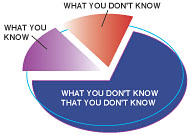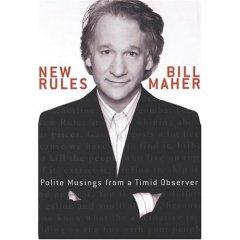Landmark Forum: a religiobiological perspective (III)
January 13th, 2005 We complete our three-part examination of Landmark Forum from the religiobiological perspective (Part I, Part II), wherein we ponder the plausibility of Landmark’s efficaciousness based on the neurotheological or religiobiological assumption: that religious experience and development is correlated with biology and/or neurology.
We complete our three-part examination of Landmark Forum from the religiobiological perspective (Part I, Part II), wherein we ponder the plausibility of Landmark’s efficaciousness based on the neurotheological or religiobiological assumption: that religious experience and development is correlated with biology and/or neurology.
Body-mind aspects. The religiobiological assumption would lead us to expect religions and personal development programs to be more effective to the extent they address the body side of the body-mind issue. This could range from rules or practices for eating, to various forms of physical practice. Zen, for instance, has its kinhin walking meditation, as well as its ōryōki eating system. A high level of religious or personal development would seem to be impossible without a smooth integration of body and mind, and thus we would expect the religion or program to talk about it or address it through its practices.
Landmark Forum completely ignores the body side of the equation. Of course, so do many other religions and systems, but the fact remains that here, at least, we find no particular support for Landmark’s promised effectiveness.
Philosophy. I’ll go out on a limb here and attempt to summarize the Landmark philosophy.
- People form and then get stuck in suboptimal identities and worldviews.
- The present contains the seeds of myriad possibilities.
- Language creates reality.
- Things are meaningless.
Philosophy—we could equally well call it ideology, or theology, or theory—forms an integral part of most religious frameworks, although in some, like Zen, it plays a lesser role. It can serve as a a guidepost and motivator and provide context to experiential development. From a religiobiological standpoint, philosophy per se is suspect in terms of its religious effect since its higher-level cortical impact is unlikely to (or we don’t know how it might) lead to any long-term changes in neurobiological structure. In order for it to be an effective part of the religion or system, at a minimum it needs to be sustained and highly coherent and targeted.
In Landmark’s case, the teaching of the philosophy is not sustained, by definition, since the program lasts only three days, although there are a number of follow-on programs. Nor, in spite of my basic sympathy for the four points above, is it coherent or targeted. It’s more like an appetizer platter.
Although it’s not my role here to critique the Landmark philosophy, I do have to object to or comment on some of these ponits.
Point 1—that people form and become prisoners of their identity and concepts—is hardly new, but certainly worthwhile to present, especially to a demographic that probably has spent little or no time pondering such things. But Landmark presents this in a vacuum, the entire discussion assuming a disembodied “I” outside the process that is apparently free of misshapen identities but explored no further.
Point 2—that language creates reality (this is not my interpretation—Landmark itself says “language may in fact be what brings that world into being”)—is actually wrong. Doubtless language is a powerful instrument for channeling and reinforcing ideas, and calling attention to that fact is useful. But as a Go player, for instance, I know the sequence of moves I plan in my mind is perfectly real, long before it takes any linguistic form, if indeed it ever does.
Point 4—that nothing means anything—is startling in the lack of connection to anything else coming before or after it on the platter. And given Landmark’s focus on terminology, or “distinctions”, it’s doubly odd that they would present this as the linchpin of their philosophy without bothering to talk about what “meaning” means.
Summary. From the religiobiological standpoint, we find nothing in particular about the Landmark program that would indicate it’s likely to be effective.
So why, to revisit the issue raised in our second post, do so many people feel they have benefited from programs such as Landmark Forum? One commentator sums it up well:
The programs have given people a positive direction and focus, and surrounded them with like-minded folks for reinforcement. They have helped them achieve peace of mind or to accomplish goals they had been unable to accomplish heretofore. They have helped with personal relationships with spouses and children or helped them justify getting out of relationships with their friends and family. The program has forced them to be more self-conscious, forced them to think and examine their lives, something most people don’t do on an ordinary Tuesday. Any time a rational person reflects on his or her life, or on some of the bigger issues in life, it feels good or it puts things in perspective. Either way, it is usually satisfying.
In other words, even if you interpret my three-part analysis as weakening Landmark’s claim to being effective (as opposed to the alternative, namely weakening the religiobiological assumption), Landmark seems to be a perfectly good program for a certain category of people and is almost certainly worth the time and money for them.
Recap. Below I bring together the six aspects that I identified in this series as being relevant in examining any framework from the religiobiological stance.
- Talking (vs. doing). What is the balance between talking/preaching and doing?
- Language (terminology). Does the system define and use a coherent terminology mapping to its worldview and practices?
- Practice. Is there a structured, regular practice which would correlate to long-term neurobiological development?
- Therapy. Does the system deal, directly or indirectly, with traumatic or damaging life experiences which can hinder early stages of development?
- Body-mind aspects. Does the system address the body side of the body-mind equation?
- Philosophy. Is the philosophy coherent, targeted, and sustained?
Clearly, there is ample room to improve on this list.

 As Numenware’s readership grows (thanks!) and its identity grows stronger, it has now moved to its own domain: www.numenware.com, obviously. Your existing links and feeds should be redirected transparently.
As Numenware’s readership grows (thanks!) and its identity grows stronger, it has now moved to its own domain: www.numenware.com, obviously. Your existing links and feeds should be redirected transparently. In honor of the 60th anniversary of the A-bomb dropped on Nagasaki, I’ll share some relevant passages from
In honor of the 60th anniversary of the A-bomb dropped on Nagasaki, I’ll share some relevant passages from  The
The  When we talk about computational models of neurotheology, what do we mean?
When we talk about computational models of neurotheology, what do we mean? Larry King, our favorite geriatric talk show host, revisited the old why-God-lets-horrible-things-happen problem on a
Larry King, our favorite geriatric talk show host, revisited the old why-God-lets-horrible-things-happen problem on a 

 Alien visitations, odd as they are, have something in common with religion: people believe in them. Why do people have the belief they were abducted by aliens? How do those beliefs relate to beliefs they or other people have about anything, including God? If we understood the neurological mechanisms underlying why people believe they were abducted by aliens could we understand why they believe in other things, including God?
Alien visitations, odd as they are, have something in common with religion: people believe in them. Why do people have the belief they were abducted by aliens? How do those beliefs relate to beliefs they or other people have about anything, including God? If we understood the neurological mechanisms underlying why people believe they were abducted by aliens could we understand why they believe in other things, including God?